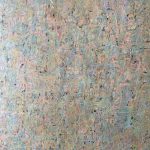Caillebotte’s Boating on the Yerres

Caillebotte, Gustave (French, 1848-1894) Boating on the Yerres (Perissoires sur l’Yerres) 1877 Oil on canvas 40 3/4 x 61 3/8 in. Gift of the Milwaukee Journal Company, in Honor of Miss Faye McBeath M1965.25
The feeling of moving mass in the current below and gliding momentum on the surface comes through powerfully in Gustav Caillebotte’s Boating on the Yerres (Perissoires sur l’Yerres).
Impression and sensation count in this 1877 painting. Caillebotte went to some lengths to create the illusion not only of movement but also of force. (If you’ve spent much time in canoes, you know the feeling.) The three boats — sporty, kayak-like craft — glide on a stream that opens in a wedge shape. The tilt of the riverbank exaggerates the downhill flow of the water. The geometry of the painting, a rough wedge expanding from the top right to the lower left, promotes the sense of downward, leftward flow. The lead boat cuts an arrowhead of light into the shadow cast by the large tree. Caillebotte couldn’t have been more specific about the direction of the painting, short of adding a No Right Turn sign. Even the sun is at the backs of the boaters, as a solar wind.
We measure their progress against a neatly arranged grid, which also gives the painting a formal structure to contain and contrast with the loose brushwork and sketchy rendering. (Caillebotte [1848-1894], an engineer by trade, painted in his spare time. What engineer can abide disorder?) The neat horizontals of the first-terrace shrubbery stabilize the piece. The horizontals intersect at 90 degrees with verticals of three straight tree trunks and their wobbly reflections in the water.
The lead and trailing boaters are sketchy and anonymous. The middle one, though, shows his face and is very much in ours. He is the focal point of the painting, just off center overall. His face is also nearly at the center of a H, a sort of frame within the frame, formed by the bank and the middle and right tree trunks. He gazes directly at the camera, as it were, so we must meet that gaze. Caillebotte means for us to wonder about him and perhaps identify with him.
The fleeting, inexact nature of perception, especially in outdoor settings constantly alive with shifting light, wind and water, attracted these painters. In such settings, the hard-edged, realism of classical painting and even of photographs became lies, in their view. When you hold the central boater’s gaze for a few seconds, the flickering, quivering, ephemeral quality of the leaves and water comes alive in peripheral vision.
The literal content of this painting is easy to read, but Caillebotte rendered only the man-made, rigid boats in sharp relief. He merely suggested everything else and left it to our brains to fill in the rest. Note especially the four small “trees” in the “middle distance.” You read them as trees immediately, but take a closer look: They’re just a few dashed-off blotches of paint. Out of context, they wouldn’t be trees. This is Caillebotte’s Impressionist joke on us, and what a charming joke it is.
Print out this or any story from our One Piece at a Time series and take it to the admissions desk for $2 off on visits to the Milwaukee Art Museum. Offer good through Sept. 12.
Art
-
Winning Artists Works on Display
 May 30th, 2024 by Annie Raab
May 30th, 2024 by Annie Raab
-
5 Huge Rainbow Arcs Coming To Downtown
 Apr 29th, 2024 by Jeramey Jannene
Apr 29th, 2024 by Jeramey Jannene
-
Exhibit Tells Story of Vietnam War Resistors in the Military
 Mar 29th, 2024 by Bill Christofferson
Mar 29th, 2024 by Bill Christofferson






















Thanks for this article, Tom. I love Caillebotte and didn’t even know this piece was in our museum! I’ll have to make a trip there soon.
You’re welcome, Lisa. Thanks for reading. — Strini